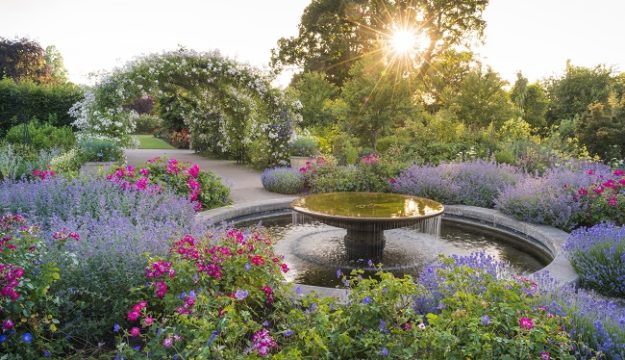 The Fountain in the Country Garden at RHS Garden Wisley is also a key part of any visit © RHS/ Joanna Kossak
The Fountain in the Country Garden at RHS Garden Wisley is also a key part of any visit © RHS/ Joanna Kossak
As snowdrops and daffodils signal spring’s approach, the Royal Horticultural Society (RHS) is sharing its top tips on how gardeners can prepare for the upcoming growing season and where to see spring highlights in RHS Gardens.
Spring is a time of hope and renewal, and this year, flowers, including daffodils, hellebores, camellias and plums, are blooming earlier, while snowdrops have been both early and more abundant. This ‘early spring’ is due to unusually mild weather in February, meaning soil temperatures are above average.
Warmer soil temperatures will promote the growth of bulbs and lawns and, in the south, at least enable early seed sowing for crops such as broad beans, lettuces, onions and peas, assuming the soil is dry enough. While rainfall has not been excessive since the new year, clay soils might not be dry enough to work until April, after a particularly wet autumn. In these cases, seeds can be sown indoors to plant out later, or cloches and cold frames can be used to speed up drying and raise soil temperatures for early sowing.
There is also plenty to get on with indoors, from sowing seeds – such as tomatoes and chillies – in pots on windowsills to chitting potatoes and repotting houseplants.
At this time of year, it’s important to assess the effects of winter and address any damage in the garden to ensure it is primed for this productive season. While it may be tempting to give the garden a complete spring clean, it is worth sparing a thought for wildlife before tidying away all of last year’s growth, as this can still provide valuable shelter for several species.
By investing time and effort now, the stage can be set for a flourishing garden that will provide colour, scent and flavour for months to come.
Here are some of the top tips for gardeners as spring brings gardens back to life:
- Support nesting birds by feeding, providing water and being careful about pruning and other potential disturbance of nests. Leave piles of moss, dead grass, and twigs to help build the nest, and keep an area of bare soil, wetting it if required so mud is always available for cementing nests.
- Help insects by sparing flowering weeds such as groundsel and red nettles until they have finished flowering. Leave piles of prunings and trimmings in out-of-the-way spots until summer. These provide shelter for insects and other creatures while conditions remain potentially harsh.
- Spread mulch around perennial plants to lock in winter rain, suppress unwanted vegetation and support soil life, especially earthworms, that, in turn, feed birds and other garden wildlife.
- Wetter than usual conditions since September in many places have left low-lying gardens and ones with clay soils very wet. Cultivating, sowing, and planting is difficult until the soil dries out, which may take until April. In the meantime, use planks to access the garden for pruning and weeding to avoid soil damage.
- Sow seeds – seeds are relatively inexpensive but are slow to get going, so aim to sow hardy vegetable seeds such as carrots, lettuce and parsnips and for flowers, calendula and love-in-the-mist as early as feasible. However, where conditions are too cold or wet to suit seeds outdoors, delaying sowing until April will give satisfactory results. Alternatively, use cloches or a cold frame to warm and dry outdoor soil for a fortnight or more before sowing.
- Sowing seeds indoors, perhaps on windowsills, enclosed porches or a coldframe where a greenhouse is not available, is necessary for tender plants with small seeds such as tomatoes, chilli peppers and tagetes. They are spoiled if they become overcrowded as they grow so raise no more than can be fitted into available space. Choose peat-free potting compost that is recommended for seed sowing.
- Potatoes can be planted from early spring for earlies and mid-spring for maincrops, ideally after sprouting in a light, frost-free place. Shallot, garlic and onion sets can also be planted as soon as the soil dries out. Leave heat-treated onion sets until mid-spring, as cold conditions induce premature flowering (bolting)
- Where slugs are abundant, as is often the case after a mild, wet winter, raising young plants indoors keeps them safe from attack, and if grown to be quite large before being planted out, they can tolerate some ‘grazing’ that would be fatal to tiny plants.
- Courgettes, pumpkins, runner beans, squash, sunflowers and sweetcorn have large seeds which will grow fast after sowing, so delay sowing these until the second half of April or even sowing outdoors, where they are to grow after mid-May.
- Bulbs are another relatively inexpensive way of getting garden colour – lilies, which flower from midsummer, are hardy and can be planted as soon as possible in spring for best results. Tender bulbs such as begonias, crinum, dahlias, gladioli, gloriosa and tigridia can be started indoors in pots or planted outdoors where they are to grow from mid-spring.
- Houseplants will start growing again now that light levels are rising and will benefit from feeding and, where necessary, repotting. However, bright windows will soon become scorching, so delicate plants are best moved to duller positions. Similarly, greenhouses will overheat on bright spring days if shading is not installed.
- Easter (Easter Sunday is 31 March), the traditional time to start gardening, is early this year, so any newly acquired tender plants will need to be protected from frost – it may be better to wait for two weeks until the weather has warmed up.
Signs of early flowering have been reported at all five RHS Gardens, where the following highlights can be enjoyed:
- At RHS Bridgewater, in Greater Manchester, there is a carpet of 20,000 snowdrops through Middle Wood and an extensive collection in the Community Coppice. Last autumn, more than 16,000 daffodils were planted in the Orchard Garden, promising a vibrant burst of colour in the weeks to come. At the same time, the Farringdon Fruit House in the Paradise Garden is awash with the heady scent of narcissi and hyacinths in bloom.
- The Royal Horticultural Society’s northernmost garden, RHS Harlow Carr, is also responding to unseasonably mild temperatures as snowdrops are all flowering early. Elsewhere, the Alpine House is alive with colour, and the Iris Walk is dazzling with the blue petals of Iris reticulata.
- At RHS Hyde Hall, near Chelmsford, visitors can enjoy over 10,000 snowdrops comprising 17 varieties, as well as 5,000 scillas (12 varieties), over 15,000 crocuses (21 varieties) and 6,000 sunshine-yellow Winter Aconites.
- In North Devon RHS, Rosemoor’s crocuses, daffodils, and cherry trees are starting to shine. The lawns are strewn with spring bulbs, while camellias provide bursts of colour in the Winter, Stone and Woodland Gardens. Meanwhile, daphne varieties will delight the senses with their intensely fragrant blooms.
- At RHS Wisley, Surrey, there are swathes of snowdrops throughout the Winter Walk, Fern Glade and Battleston Hill, while in the Alpine House, visitors can admire a selection of rare and unusual varieties at close quarters. As mild weather continues, the Conifer Lawn will soon be a carpet of purples, mauves and whites as 200,000 crocuses burst to life, with cultivars including ‘Pickwick’ and ‘Jeanne d’Arc’. Recent temperatures have also enabled Wisley’s vast Camellia collection to flower without frost damage.
Guy Barter, RHS Chief Horticulturist, said: “Spring marks the start of an exciting time in the garden, with plenty to look forward to. This year, mild weather has caused some plants to bloom early, bringing a premature flush of flowers to gardens across the country. After a particularly wet autumn, the ground will take longer to dry in some areas, meaning affected gardeners should resist sowing until soils dry out in April to avoid disappointing results. While seeds can be sown indoors, there are still plenty of outdoor tasks to get on with, such as mulching perennial plants and pulling up emergent weeds. Patience and careful soil management will pave the way for a successful spring in the garden.”
For ideas on planning tours to the RHS, visit www.rhs.org.uk





